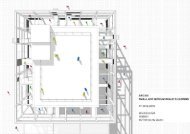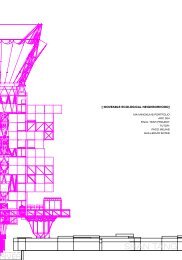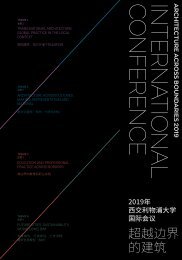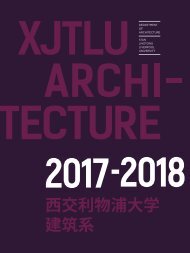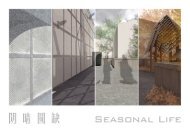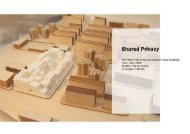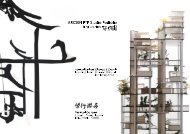YEARBOOK 2018 - 2019 | XJTLU DEPARTMENT OF ARCHITECTURE
The sixth edition of the yearbook of the Department of Architecture at Xi'an Jiaotong-Liverpool University presents student works created during the academic year 2018 - 2019. The yearbook exemplifies the new model for Chinese architectural education for which the department was commended by the Royal Institute of British Architects (RIBA). It is also a showcase of the creative culture that has guided our students towards successful international careers as responsible and creative architectural designers. The Department of Architecture at XJTLU offers RIBA Part 1, 2 and 3.
The sixth edition of the yearbook of the Department of Architecture at Xi'an Jiaotong-Liverpool University presents student works created during the academic year 2018 - 2019. The yearbook exemplifies the new model for Chinese architectural education for which the department was commended by the Royal Institute of British Architects (RIBA). It is also a showcase of the creative culture that has guided our students towards successful international careers as responsible and creative architectural designers. The Department of Architecture at XJTLU offers RIBA Part 1, 2 and 3.
You also want an ePaper? Increase the reach of your titles
YUMPU automatically turns print PDFs into web optimized ePapers that Google loves.
143<br />
144<br />
BRIEF B<br />
Open Architecture<br />
<strong>2018</strong>-<strong>2019</strong> <strong>YEARBOOK</strong> Xi’an Jiaotong-Liverpool University Department of Architecture 西 交 利 物 浦 大 学 建 筑 系<br />
Architecture cannot be, nowadays, considered without understanding the<br />
intricate relationship between local context and global development. Global<br />
civilisation and local culture are now inextricably linked in sometimes symbiotic,<br />
sometimes diverging ways. They could be surmised as two, dynamically linked,<br />
permanently emerging and intertwined, faces of our discipline - Architecture.<br />
In this context we wish to interrogate the meaning of openness in architecture:<br />
What does Open Architecture look like in the ambit of a multi-cultural<br />
international China?<br />
How does a multi-millenary culture cope with the need to co-exist with and<br />
advertise to, and perhaps even, ingratiate itself with other cultures?<br />
What is the link between public space and civil society in an evolving China?<br />
Can China in its current embodiment successfully provide both the stability and<br />
the cultural openness it requires to effectively interact with foreign countries in a<br />
spirit of mutual respect?<br />
What bold vision can we propose for the future of China?<br />
Through rapid changes brought to the field in both scale, speed, and efficiency<br />
of development, Architecture has evolved into a multi-faceted discipline: one<br />
tackling an increasing number of specialties and collaborations, and involved<br />
in more and more complex endeavours... while taking the current state of the<br />
field into consideration, Students are asked to design a building that is also an<br />
architectural testimony to artistic, cultural, environmental, or socio-cultural<br />
values, relevant to the Brief’s above questions.<br />
Reflecting on the challenges brought by China’s rise on the global stage<br />
may allow architecture students to re-think the transformative potential of<br />
architecture and to clarify the evolving relationship between local culture<br />
and the global society, through designing a socio-cultural space, or a mix of<br />
commercial and residential spaces, dealing with the concept of openness or<br />
confinement. The terms Openness and Confinement can be interpreted in any<br />
sense deemed interesting by the student participating in this FYP brief, while<br />
chosen and developed in close coordination with their tutor, provided that they<br />
can convincingly argue that their approach is meaningful and justified.<br />
Open Architecture can therefore refer to either spatial, historical, technological,<br />
cultural, or physical openness or confinement, in any relevant manner, but in<br />
any case it requires to refer to the relationship between China and the Globalised<br />
world.<br />
TEACHING TEAM<br />
Li-An Tsien<br />
CO-CONSTRUCTED ART CITY<br />
Xinning Yu | 郁 歆 宁







